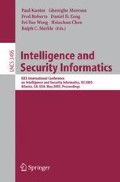Abstract
Emergency response systems play an important role in homeland security nowadays. Despite this, research in the design of emergency response systems is lacking. An effective design of emergency response system involves multi-disciplinary design considerations. On the basis of emergency response system requirement analysis, in this paper, we develop a set of supporting design concepts and strategic principles for an architecture for a coordinated multi-incident emergency response system
Access this chapter
Tax calculation will be finalised at checkout
Purchases are for personal use only
Preview
Unable to display preview. Download preview PDF.
References
Probasco, K., Mogle, R.: The 21st Century First Responder: The Vision. Prepared for the U.S. Department of Energy under Contract DE-AC06-76RLO 1830 (1998)
Dykstra, E.: Toward an International System Model in Emergency Management. In: Public Entity Risk Institute Symposium (2003)
Neal, D.: Transition from Response to Recovery: A Look at the Lancaster, Texas, Tornado. Journal of Emergency Management 2(1) (2004)
Arens, Y., Rosenbloom, P.: Responding to the Unexpected. Communication of ACM 46(9) (September 2003)
Shen, S., Shaw, M.: Managing Coordination in Emergency Response Systems with Information Technologies. IT for Emergency Response System Coordination. In: Proceedings of the Tenth American Conference on Information Systems, New York (2004)
Mehrotra, S.: Project Rescue: Challenges in Responding to the Unexpected. In: Proceedings of 16th Annual Symposium on Electronic Imaging Science and Technology, San Jose, CA (2004)
Gillis, B.: E-Safety: Saving Lives and Enhancing Security for Washington Citizens. WSU Center to Bridge the Digital Divide. White Paper 2003.06.01 (2003)
Macko, S.: The Threat of Chemical and Biological Attack. Emergency Net News (ENN) Daily Report, 08/27/96 (1996)
Shea, D.: Small-scale Terrorist Attacks Using Chemical and Biological Agents: An Assessment Framework and Preliminary Comparisons. In: Congressional Research service, May 20 (2004)
Jump, P., Bruce, J.: The Response Factor. Electric Perspectives 28(3), 22 (2003), ABI/INFORM Global
Department of Homeland Security, http://www.dhs.org/
Green, L.: Improving Emergency Responsiveness with Management Science. Emergency Service Model, 1 (2000)
Carafano, J.: Preparing Responders to Respond: The Challenges to Emergency Preparedness in the 21st Centry. Heritage Lectures 812 (November 20, 2003)
Wimberly, R.: How Quickly Can We Respond. Occupational Health & Safety 73(4), 46 (2004), ABI/INFORM Global
Walks, I.: Emergency Response outside the Envelope. Security Management 53 (2003)
Turoff, M.: The Design of A Dynamic Emergency Response Management Information System (DERMIS). Journal of Information Technology Theory and Application 5(4), 1 (2004), ABI/INFORM Global
Baligh, H., Burton, R.M., Obel, B.: Designing organization structures: An expert system method. In: Roos, J.L. (ed.) Economics and Artificial Intelligence, Pergamon, Oxford, pp. 177–181 (1985)
Rao, R., Chaudhury, A., Chakka, M.: Modeling Team Processes: Issues and a Specific Example. Information Systems Research 6(3), 255–285 (1995)
Malone, T.: The Interdisciplinary Study of Coordination. ACM Computing Surveys 26(1) (1994)
Crowston, K.: Coordination Theory. Human-Computer Interaction in Management Information Systems, vol. I.M.E. Sharpe (2001)
Crowston, K.: A Coordiantion Theory Approach to Process Description and Redesign. In: Malone, T.W., Crowston, K., Herman, G. (eds.) Organizing Business Knowledge: The MIT Process Handbook. MIT Press, Cambridge (2002)
Van Der Aalst, W.: Workflow Patterns. Distributed and Parallel Databases 14(1), 5–51 (2003), ISSN:0926-8782
Chaffee, M.: DVATEX: Navy Medicine’s Pioneering Approach to Improving Hospital Emergency Preparedness. Journal of Emergency Management 2(1) (2004)
Business & Finance Bulletin IS-3 Electronic Information Security, November 12. University of California, California (1998)
Sawyer, S.: Mobility and the First Responder. Communications of the ACM 47(3) (March 2004)
Anderson, P.: Information Technology: Where is It in the Coordination of Emergency Services. In: Asia Pacific Police Technology Conference (1991)
Jenvald, J.: Simulation-supported Live Training for Emergency Response in Hazardous Environments. Simulation & Gaming (2004)
Huang, Y., Garcia-Molina, H.: Publish/Subscribe in a Mobile Environment. In: 2nd ACM International Workshop on Data Engineering for Wireless and Mobile Access, MobiDE (2001)
NIMS Document Directory (March 1, 2004), http://www.nimsonline.com/nims_3_04/index.htm
State and Local Guide (SLG) 101: Guide for All-Hazard Emergency Operations Planning: First eponders – FEMA, http://www.fema.gov/fema/first_res.shtm
Incident Command System, US Coast Guard Site, http://www.uscg.mil/hq/gm/mor/Articles/ICS.htm
Consequences Assessment Tool Set (CATS), http://www.saic.com/products/simulation/cats/cats.html
Raghu, T.S., Jayaraman, B., Rao, H.R.: Toward an Integration of Agent- and Activity-Centric Approaches in Organizational Process Modeling: Incorporating Incentive Mechanisms. Information Systems Research 15(4) (2004)
Savas, E.S.: Simulation and Cost-effectiveness Analysis of New York’s Emergency Ambulance Service. Management Science 23(2), 146–158 (1976)
Fitzsimmons, J.A.: A Methodology for Emergency Ambulance Deployment. Management Science 19(6), 627–636 (1973)
Rider, K.L.: A Parametric Model for the Allocation of Fire Companies in New York City. Management Science 23(2), 146–158 (1976)
Green, L.: A Multiple Dispatch Queuing Model of Police Patrol Operations. Management Science 30(6), 653–664 (1984)
Jenvald, J., Morin, M.: Simulation-supported Live Training for Emergency Response in Hazardous Environments. Simulation and Gaming 35(3), 363–377 (2004)
Author information
Authors and Affiliations
Editor information
Editors and Affiliations
Rights and permissions
Copyright information
© 2005 Springer-Verlag Berlin Heidelberg
About this paper
Cite this paper
Chen, R., Sharman, R., Rao, H.R., Upadhyaya, S. (2005). Design Principles of Coordinated Multi-incident Emergency Response Systems. In: Kantor, P., et al. Intelligence and Security Informatics. ISI 2005. Lecture Notes in Computer Science, vol 3495. Springer, Berlin, Heidelberg. https://doi.org/10.1007/11427995_8
Download citation
DOI: https://doi.org/10.1007/11427995_8
Publisher Name: Springer, Berlin, Heidelberg
Print ISBN: 978-3-540-25999-2
Online ISBN: 978-3-540-32063-0
eBook Packages: Computer ScienceComputer Science (R0)

